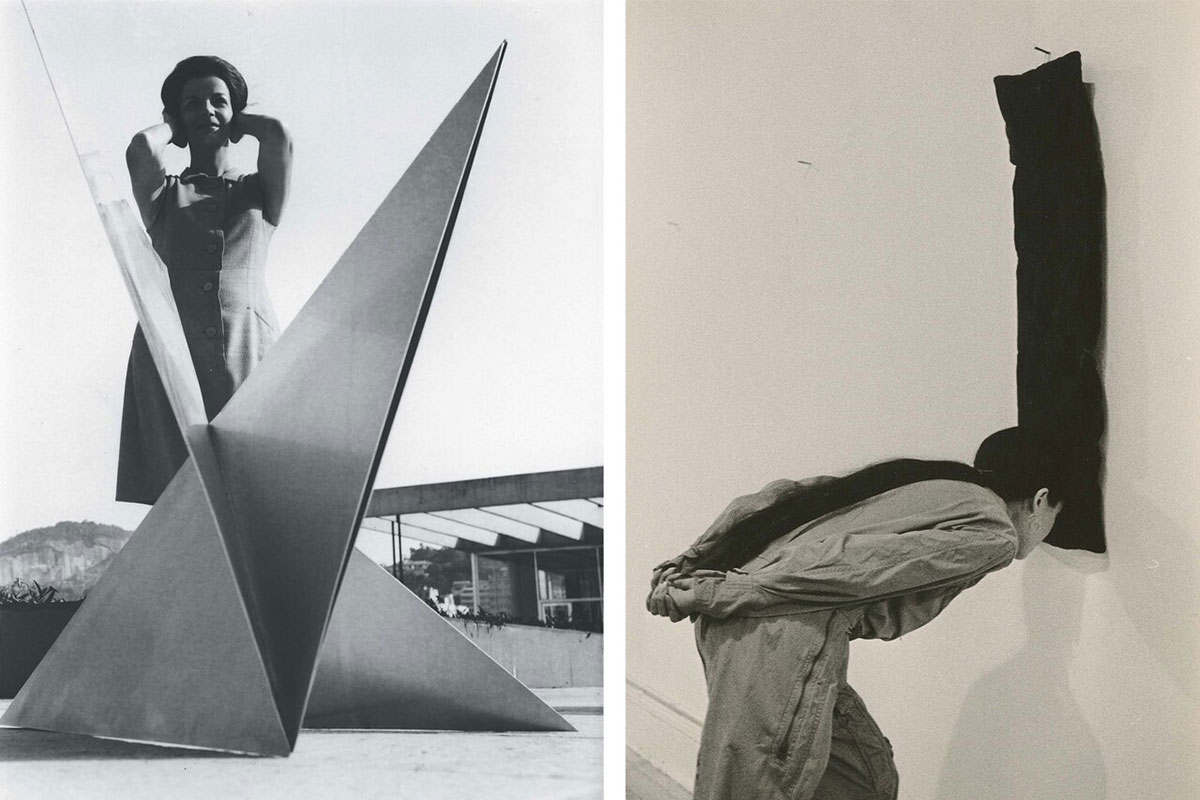PRESENTATION: Lygia Clark & Franz Erhard Walther-Action as Sculpture
 The exhibition “Action as Sculpture” is an encounter between two artists who never met in person. In an exchange of letters between Yve-Alain Bois and Franz Erhard Walther in the early 1970’s, the young art historian and life-time friend of Lygia Clark told Walther about the Brazilian artist’s work and provided him with a copy of a review of her work from 1968. In the same letter in which Bois references this review, he quotes Clark’s positive reaction to Walther’s work, which she had seen in images likewise provided by Bois.
The exhibition “Action as Sculpture” is an encounter between two artists who never met in person. In an exchange of letters between Yve-Alain Bois and Franz Erhard Walther in the early 1970’s, the young art historian and life-time friend of Lygia Clark told Walther about the Brazilian artist’s work and provided him with a copy of a review of her work from 1968. In the same letter in which Bois references this review, he quotes Clark’s positive reaction to Walther’s work, which she had seen in images likewise provided by Bois.
By Dimitris Lempesis
Photo: Villa Franz Erhard Walther Archive
The works presented in the dialogical exhibition “Action as Sculpture” were produced before both artists knew about the work of the other, which in the early 1970’s remained limited to Bois’s description and the mediation of reproductions in books. The works on view date from the late 1950’s to 1963, marking a period in which both artists engaged with concepts of painting from their respective cultural contexts – in the case of Lygia Clark, concrete art and geometric abstraction in Brazil, and in the case of Walther, Informel in Germany – from which they developed the participatory conception of their respective oeuvres. 1963 was a year of radical departure for both artists: Clark created her seminal work “Caminhando” (Walking) and Walther produced the first pieces of his seminal “First Work Set”. With these works, both artists revolutionized the role of the viewers, changing their position from observers to active participants in the realization of the work. Neo-Concrete movement (1959–66), was a Brazilian vanguard movement that rejected the impersonal and objective quality of concrete abstraction. The Neo-Concretists conceived of their works as existing between art and life, as tools for experiences in the public realm. For Clark, Neo-Concretism initiated an investigation that led her to a practice beyond the limits of conventional artistic forms. Around 1960, Clark found a way to unfold the topological investigations of her Neo-Concretist paintings into a three-dimensional repertoire. The result was her series of sculptures known as “Bichos” (Critters). These were the first participatory works by Clark meant to be fully and endlessly reshaped by their interaction with the beholders. In the Bichos the organic lines become hinges between panels, allowing the sculpture to be transformed from schematic flatness into a variety of unexpected three-dimensional configurations. In 1963, Clark made a work titled “Caminhando” (Walking) by twisting a strip of paper 180 degrees, gluing its ends together to create a Möbius strip (a circular form that appears to have two sides but actually has only one), and cutting around and around its length until it was too thin to cut further. This was the first of Clark’s “propositions”—works that spectators were invited to take part in creating, thus becoming more than simply spectators. In the words of the artist, “the work is the act.” Franz Erhard Walther is recognized as a pioneer of participatory art whose work, beginning in the late 1950s, has been defined by a radical openness, incorporating. Franz Erhard Walther’s 1960s work with the body hasn’t received the same critical attention as that of Chris Burden or Bruce Nauman, perhaps because it never engaged issues of popular culture. What’s more, Walther himself was seldom the protagonist. Instead, he choreographed other bodies in scenarios akin to the experimental dance of Trisha Brown and Yvonne Rainer. And his sensibility is emphatically European, the photographs of these performances recalling the brooding existentialist films of Ingmar Bergman. Inherent in the experimentation with existing image and text material from his immediate surroundings in Fulda in the late 1950s and early 1960s (daily newspapers, advertisements, wrapping paper from local shops) is also the intention to overcome the conventional handling of image and writing and to transfer these into formative and sensory material processes: tearing, folding, crumpling, sweeping up, wrapping. For his “First Work Set” (1963–1969), in which the use of simple physical actions like pressing, folding, and wrapping is a key principle, the potential handling of the work becomes imperative to its construction. In the works’ activation, the viewer is provided with a unique experience wherein the body becomes an extension of the object. Walther’s works allow multiple exhibition possibilities, primarily with regard to their activation or inactivation. Polymorphic, it can be hung or leaned against the wall, placed on horizontal supports, or even stored in receptacles or fabric membranes. This fluid configuration expands the boundless permutations of the sculptural form, an idea further expanded through his drawing practice. For Walther, both mediums bring to focus a central concern: the physical act of creation.
Photo left: Portrait of Lygia Clark with Bicho Ponta. Rio de Janeiro, n/d. © Associação Cultural o Mundo de Lygia Clark Archive. Photo: Revista Manchete. Photo right: Franz Erhard Walther, Forehead Piece, No. 1, 1963. From First Work Set, 1963–1969. © Franz Erhard Walther / VG Bild-Kunst 2023. Photo: Barbara Brown
Info: Curator: Daniela Labra, Villa Franz Erhard Walther, Paulustor 4, Fulda, Germany, Duration: 9/12/2023-30/6/2024, Days & Hours: Fri 14:00-20:00, Sat-Sun 11:00-18:00, https://villa-few.com/


